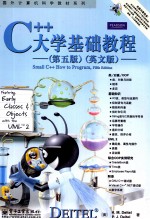图书介绍
C++大学基础教程 英文版【2025|PDF|Epub|mobi|kindle电子书版本百度云盘下载】

- H·M·Deitel著 著
- 出版社: 北京:电子工业出版社
- ISBN:9787121118586
- 出版时间:2010
- 标注页数:573页
- 文件大小:234MB
- 文件页数:612页
- 主题词:C语言-程序设计-高等学校-教材-英文
PDF下载
下载说明
C++大学基础教程 英文版PDF格式电子书版下载
下载的文件为RAR压缩包。需要使用解压软件进行解压得到PDF格式图书。建议使用BT下载工具Free Download Manager进行下载,简称FDM(免费,没有广告,支持多平台)。本站资源全部打包为BT种子。所以需要使用专业的BT下载软件进行下载。如BitComet qBittorrent uTorrent等BT下载工具。迅雷目前由于本站不是热门资源。不推荐使用!后期资源热门了。安装了迅雷也可以迅雷进行下载!
(文件页数 要大于 标注页数,上中下等多册电子书除外)
注意:本站所有压缩包均有解压码: 点击下载压缩包解压工具
图书目录
Chapter 1 Introduction to Computers,the Internet and World Wide Web1
1.1 Introduction2
1.2 What Is a Computer?3
1.3 Computer Organization3
1.4 Early Operating Systens4
1.5 Personal,Distributed and Client/Server Computing4
1.6 The Internet and the World Wide Web4
1.7 Machine Languages,Assembly Languages and High-Level Languages5
1.8 History of C and C++6
1.9 C++Standard Library6
1.10 History of Java7
1.11 FORTRAN,COBOL,Pascal and Ada7
1.12 Basic,Visual Basic,Visual C++,C# and .NET8
1.13 Key Software Trend:Object Technology8
1.14 Typical C++Development Environment9
1.15 Notes About C++and Small C++How to Program,5/e11
1.16 Test-Driving a C++Application12
1.17 Introduction to Object Technology and the UML16
1.18 Wrap-Up20
1.19 Web Resources21
Chapter 2 Introduction to C++Programming28
2.1 Introduction28
2.2 First Program in C++:Printing a Line of Text29
2.3 Modifying Our First C++Progran31
2.4 Another C++Program:Adding Integers32
2.5 Memory Concepts35
2.6 Arithmetic36
2.7 Decision Making:Equality and Relational Operators39
2.8 Wrap-Up42
Chapter 3 Introduction to Classes and Objects50
3.1 Introduction51
3.2 Classes,Objects,Member Functions and Data Members51
3.3 Overview of the Chapter Examples52
3.4 Defining a Class with a Member Function52
3.5 Defining a Member Function with a Parameter55
3.6 Data Members,set Functions and get Functions57
3.7 Initializing Objects with Constructors62
3.8 Placing a Class in a Separate File for Reusability65
3.9 Separating Interface from Implementation68
3.10 Validating Data with set Functions72
3.11 Wrap-Up76
Chapter 4 Control Statements:Part 182
4.1 Introduction83
4.2 Algorithms83
4.3 Pseudocode83
4.4 Control Structures84
4.5 if Selection Statement87
4.6 if...else Double-Selection Statement88
4.7 while Repetition Statement92
4.8 Formulating Algorithms:Counter-Controlled Repetition93
4.9 Formulating Algorithms:Sentinel-Controlled Repetition97
4.10 Formulating Algorithms:Nested Control Statements105
4.11 Assignment Operators108
4.12 Increment and Decrement Operators109
4.13 Wrap-Up111
Chapter 5 Control Statements:Part 2124
5.1 Introduction125
5.2 Essentials ofCounter-Controlled Repetition125
5.3 for Repetition Statement126
5.4 Examples Using the for Statement130
5.5 do...while Repetition Statement133
56 swi tch Multiple-Selection Statement134
5.7 break and continue Statements141
5.8 Logical Operators143
5.9 Confusing Equality(==)and Assignment(=)Operators146
5.10 Structured Programming Summary147
5.11 Wrap-Up150
Chapter 6 Functions and an Introduction to Recursion159
6.1 Introduction160
6.2 Program Components in C++160
6.3 Math Library Functions162
6.4 Function Deftnitions with Multiple Parameters162
6.5 Function Prototypes and Argument Coercion166
6.6 C++Standard Library Header Files168
6.7 Case Study:Random Number Generation169
6.8 Case Study:Garne ofChance and Introducing enum173
6.9 Storage Classes175
6.10 Scope Rules177
6.11 Function Call Stack andActivation Records180
6.12 Functions with Empty Parameter Lists182
6.13 Inline Functions183
6.14 References and Reference Parameters184
6.15 DefaultArguments188
6.16 Unary Scope Resolution Operator189
6.17 Function Overloading190
6.18 Function Templates192
6.19 Recursion194
6.20 Example Using Recursion:Fibonacci Series196
6.21 Recursion vs.Iteration199
6.22 Wrap-Up200
Chapter 7 Arrays and Vectors218
7.1 Introduction218
7.2 Arravs219
7.3 Declaring Arrays220
7.4 Examples Using Arrays221
7.5 Passing Arrays to Functions232
7.6 Case Study:Class GradeBook Using an Array to Store Grades235
7.7 Searching Arrays with Linear Search240
7.8 Sorting Arrays with Insertion Sort241
7.9 Multidimensional Arrays243
7.10 Case Study:Class GradeBook Using a Two-Dimensional Array245
7.11 Introduction to C++Standard Library Class Template vector250
7.12 Wrap-Up253
Chapter 8 Pointers and Pointer-Based Strings267
8.1 Introduction268
8.2 Pointer Variable Declarations and Initialization268
8.3 Pointer Operators269
8.4 Passing Arguments to Functions by Reference with Pointers271
8.5 Using const with Pointers274
8.6 Selection Sort Using Pass-by-Reference279
8.7 sizeof Operators281
8.8 Pointer Expressions and Pointer Arithmetic283
8.9 Relationship Between Pointers and Arrays285
8.10 Arrays of Pointers288
8.11 Case Study:Card Shuffling and Dealing Simulation289
8.12 Function Pointers293
8.13 Introduction to Pointer-Based String Processing297
8.14 Wrap-Up304
Chapter 9 Classes:A Deeper Look,Part 1324
9.1 Introduction325
9.2 Time Class Case Study325
9.3 Class Scope and Accessing Class Members329
9.4 Separating Interface from Implementation331
9.5 Access Functions and Utility Functions332
9.6 Time Class Case Study:Constructors with Default Arguments334
9.7 Destructors337
9.8 When Constructors and Destructors Are Called338
9.9 Time Class Case Study:A Subtle Trap—Returning a Reference to a private Data Member340
9.10 Default Memberwise Assignment342
9.11 Software Reusability344
9.12 Wrap-Up344
Chapter 10 Classes:A Deeper Look,Part 2350
10.1 Introduction351
10.2 const(Constant)Objects and const Member Functions351
10.3 Composition:Objects as Members of Classes357
10.4 friend Functions and friend Classes362
10.5 Using the this Pointer365
10.6 Dynamic Memory Management with Operators new and delete368
10.7 static Class Members370
10.8 Data Abstraction and Information Hiding374
10.9 Container Classes and Iterators376
10.10 Proxy Classes376
10.11 Wrap-Up379
Chapter 11 Operator Overloading;String and Array Objects384
11.1 Introduction385
11.2 Fundamentals of Operator Overloading385
11.3 Restrictions on Operator Overloading386
11.4 OperatorFunctions as Class Members vs.Global Functions387
11.5 Overloading Stream Insertion and Stream Extraction Operators388
11.6 Overloading Unary Operators391
11.7 Overloading Binary Operators391
11.8 Case Study:Array Class392
11.9 Converting between Types400
11.10 Case Study:String Class401
11.11 Overloading++and--410
11.12 Case Study:A Date Class411
11.13 Standard Library Class string414
11.14 explicit Constructors417
11.15 Wrap-Up419
Chapter 12 Object-Oriented Programming:Inheritance428
12.1 Introduction429
12.2 Base Classes and Derived Classes430
12.3 protected Members431
12.4 Relationship between Base Classes and Derived Classes432
12.5 Constructors and Destructors in Derived Classes453
12.6 public,protected and private Inheritance459
12.7 Software Engineering with Inheritance459
12.8 Wrap-Up460
Chapter 13 Object-Oriented Programming:Polymorphism465
13.1 Introduction466
13.2 Polymorphism Examples467
13.3 Relationships Among Objects in an Inheritance Hierarchy468
13.4 Type Fields and switch Statements480
13.5 Abstract Classes and Pure virtual Functions480
13.6 Case Study:Payroll System Using Polymorphism482
13.7 (Optional)Polymorphism,Virtual Functions and Dynamic Binding"Under the Hood"494
13.8 Case Study:Payroll System Using Polymorphism and Run-Time Type Information with Downcasting,dynamic_cast,typeid and type_info497
13.9 Virtual Destructors499
13.10 Wrap-Up500
Appendix A Operator Precedence and Associativity Chart504
Appendix B ASCII Character Set506
Appendix C Fundamental Types507
Appendix D Number Systems508
Appendix E C++Internet and Web Resources518
Appendix F Using the Visual Studio.NET Debugger522
Appendix G Using the GNU C++Debugger534
Bibliography547
Index551
热门推荐
- 430396.html
- 3073919.html
- 2982457.html
- 1252384.html
- 2457726.html
- 2073908.html
- 936508.html
- 1056745.html
- 1854638.html
- 526552.html
- http://www.ickdjs.cc/book_1866777.html
- http://www.ickdjs.cc/book_274376.html
- http://www.ickdjs.cc/book_3211397.html
- http://www.ickdjs.cc/book_2017245.html
- http://www.ickdjs.cc/book_1393743.html
- http://www.ickdjs.cc/book_1542720.html
- http://www.ickdjs.cc/book_39723.html
- http://www.ickdjs.cc/book_1795221.html
- http://www.ickdjs.cc/book_1996966.html
- http://www.ickdjs.cc/book_1986780.html